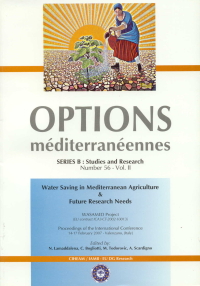| Article précédent | p. 45-59 | Article suivant |
Water saving potentialities through the use of saline water and the application of deficit irrigation
This work was conducted in the greenhouse of the Mediterranean Agronomic Institute of Bari, aiming to have further information characterizing the response of different durum wheat varieties to saline irrigation pratices (5 and 10ds/m) using different irrigation regimes (100, 60 and 40 percent of Etc). The presented data indicate clearly that the resistance to salt stress, as well as water stress varies greatly due to the variation in the studied wheat varieties. The findings show also that the vegetative growth and the grain yield production can tolerate salinity up to 5ds/m, which could be raised up to 10ds/m resulting in only 10 percent losses in the grain production. As a result, the apparent losses in the yield production under deficit irrigation using the saline water in fundamentally attributed to the water stress conditions. However, deficit irrigation with an appropriate Etc percentage and irrigation salinity level, is a win-win game as it provides good fresh water saving, acceptable yield production besides maintening the soil salinity relatively low.
- [ Afficher ]
- [ Télécharger ]
- [ Exporter la citation ]
Vous pouvez télécharger la citation au format :
- [ Imprimer ]
-
Mots-clés
CONSERVATION DE L'EAU, DOSE D'IRRIGATION, EAU SALINE, METHODE D'IRRIGATION, RENDEMENT DES CULTURES, TRITICUM DURUMCiter cet article
Hamdy A., Katerji N., Mastrorilli M., Dayyoub A. Water saving potentialities through the use of saline water and the application of deficit irrigation. In : Lamaddalena N. (ed.), Bogliotti C. (ed.), Todorovic M. (ed.), Scardigno A. (ed.). Water saving in Mediterranean agriculture and future research needs [Vol. 2]. Bari : CIHEAM, 2007. p. 45-59. (Options Méditerranéennes : Série B. Etudes et Recherches; n. 56 Vol.II). Proceedings of the International Conference WASAMED Project (EU contract ICA3-CT-2002-10013), 2007/02/14-17, Valenzano (Italy). http://om.ciheam.org/om/pdf/b56_2/00800176.pdf



